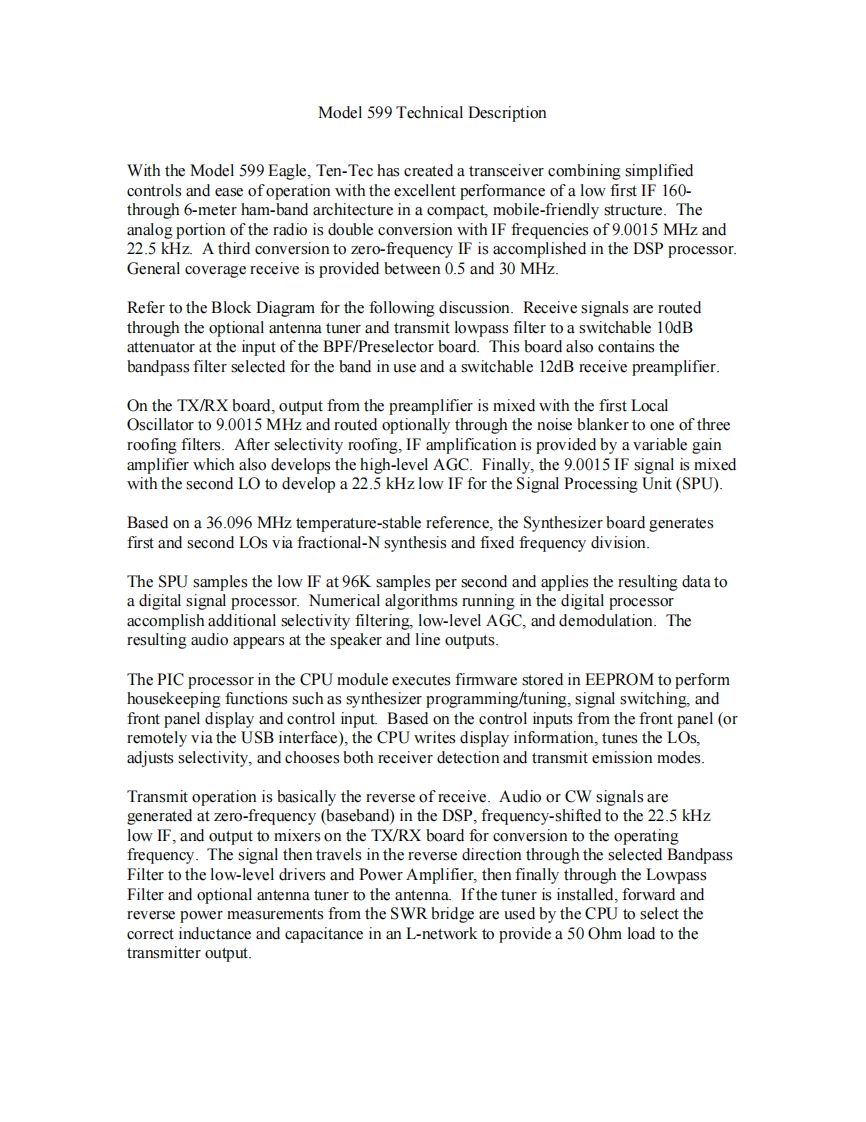

第1页 / 共18页
试读已结束,还剩17页,您可下载完整版后进行离线阅读
THE END
Model 599 Technical DescriptionWith the Model 599 Eagle,Ten-Tec has created a transceiver combining simplifiedcontrols and ease of operation with the excellent performance of a low first IF 160-through 6-meter ham-band architecture in a compact,mobile-friendly structure.Theanalog portion of the radio is double conversion with IF frequencies of 9.0015 MHz and22.5 kHz.A third conversion to zero-frequency IF is accomplished in the DSP processorGeneral coverage receive is provided between 0.5 and 30 MHzRefer to the Block Diagram for the following discussion.Receive signals are routedthrough the optional antenna tuner and transmit lowpass filter to a switchable 10dBattenuator at the input of the BPF/Preselector board.This board also contains thebandpass filter selected for the band in use and a switchable 12dB receive preamplifier.On the TX/RX board,output from the preamplifier is mixed with the first LocalOscillator to 9.0015 MHz and routed optionally through the noise blanker to one of threeroofing filters.After selectivity roofing,IF amplification is provided by a variable gainamplifier which also develops the high-level AGC.Finally,the 9.0015 IF signal is mixedwith the second LO to develop a 22.5 kHz low IF for the Signal Processing Unit(SPU).Based on a 36.096 MHz temperature-stable reference,the Synthesizer board generatesfirst and second LOs via fractional-N synthesis and fixed frequency division.The SPU samples the low IF at 96K samples per second and applies the resulting data toa digital signal processor.Numerical algorithms running in the digital processoraccomplish additional selectivity filtering,low-level AGC,and demodulation.Theresulting audio appears at the speaker and line outputs.The PIC processor in the CPU module executes firmware stored in EEPROM to performhousekeeping functions such as synthesizer programming/tuning,signal switching,andfront panel display and control input.Based on the control inputs from the front panel (orremotely via the USB interface),the CPU writes display information,tunes the LOs,adjusts selectivity,and chooses both receiver detection and transmit emission modes.Transmit operation is basically the reverse of receive.Audio or CW signals aregenerated at zero-frequency (baseband)in the DSP,frequency-shifted to the 22.5 kHzlow IF,and output to mixers on the TX/RX board for conversion to the operatingfrequency.The signal then travels in the reverse direction through the selected BandpassFilter to the low-level drivers and Power Amplifier,then finally through the LowpassFilter and optional antenna tuner to the antenna.If the tuner is installed,forward andreverse power measurements from the SWR bridge are used by the CPU to select thecorrect inductance and capacitance in an L-network to provide a 50 Ohm load to thetransmitter output.


请登录后查看评论内容